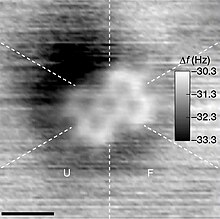Perylenetetracarboxylic dianhydride

| |

| |
| Names | |
|---|---|
| Preferred IUPAC name
Peryleno[3,4-cd:9,11-c′d′]dipyran-3,5,10,12-tetrone | |
| Other names
Perylene-3,4,9,10-tetracarboxylic dianhydride, Pigment Red 224
| |
| Identifiers | |
3D model (
JSmol ) |
|
| ChemSpider | |
ECHA InfoCard
|
100.004.461 |
| EC Number |
|
PubChem CID
|
|
| UNII | |
CompTox Dashboard (EPA)
|
|
| |
| |
| Properties | |
| C24H8O6 | |
| Molar mass | 392.32 |
| Density | 1.7 g/cm3 |
| Melting point | ~350 °C[1] |
| Structure | |
Monoclinic , P21/c
| |
Except where otherwise noted, data are given for materials in their standard state (at 25 °C [77 °F], 100 kPa).
| |
Perylenetetracarboxylic dianhydride (PTCDA) is an
pigments and dyes. It is a dark red solid with low solubility in aromatic solvents. The compound has attracted much interest as an organic semiconductor.[2]
Structure
PTCDA consists of a
monoclinic
symmetry and a density of ca. 1.7 g/cm3, which is relatively high for organic compounds. Their lattice parameters are:
| Form | a | b | c | γ |
|---|---|---|---|---|
| α | 0.374 nm | 1.196 nm | 1.734 nm | 98.8° |
| β | 0.378 nm | 1.930 nm | 1.077 nm | 83.6° |
Self-assembly and films

scanning tunneling microscopy image.[5]
Use
The main industrial use of PTCDA is as a precursor to Rylene dyes.[6][7]
References
Wikimedia Commons has media related to PTCDA.

